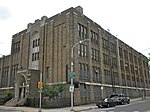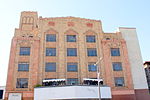The Tyler School of Art and Architecture is based at Temple University, a large, urban, public research university in Philadelphia, Pennsylvania. Tyler currently enrolls about 1,350 undergraduate students and about 200 graduate students in a wide variety of academic degree programs, including architecture, art education, art history, art therapy, ceramics, city and regional planning, community arts practices, community development, facilities management, fibers and material studies, glass, graphic and interactive design, historic preservation, horticulture, landscape architecture, metals/jewelry/CAD-CAM, painting, photography, printmaking, sculpture and visual studies.Founded in 1935 by Stella Elkins Tyler and sculptor Boris Blai in nearby Elkins Park, Pennsylvania, Tyler moved to a new, 255,000-square-foot facility at Temple's Main Campus in 2009 with the cornerstone financial support of an allocation of $61.5 million from the Commonwealth of Pennsylvania. In 2012, Tyler's Architecture programs moved into a new facility connected to the main Tyler building. Temple's programs in Landscape Architecture and Horticulture (based primarily at Temple's suburban Ambler Campus) and its programs in Main Campus-based City & Regional Planning and Community Development programs joined Tyler in 2016, unifying all of the university's architecture and environmental design disciplines in one school for the first time.In 2017, arts administrator, art historian and curator Susan E. Cahan, formerly associate dean and dean for the arts at Yale College at Yale University, was appointed dean of the Tyler School of Art and Architecture by Temple President Richard M. Englert.In 2018, Temple University's board of trustees approved changes to Tyler's structure and identity in order to unify the school, integrate disciplines in architecture and environmental design, support cross-disciplinary studies and reflect current understanding of creative practice and research. On July 1, 2019, the school's name officially expanded from the Tyler School of Art to the Tyler School of Art and Architecture.






